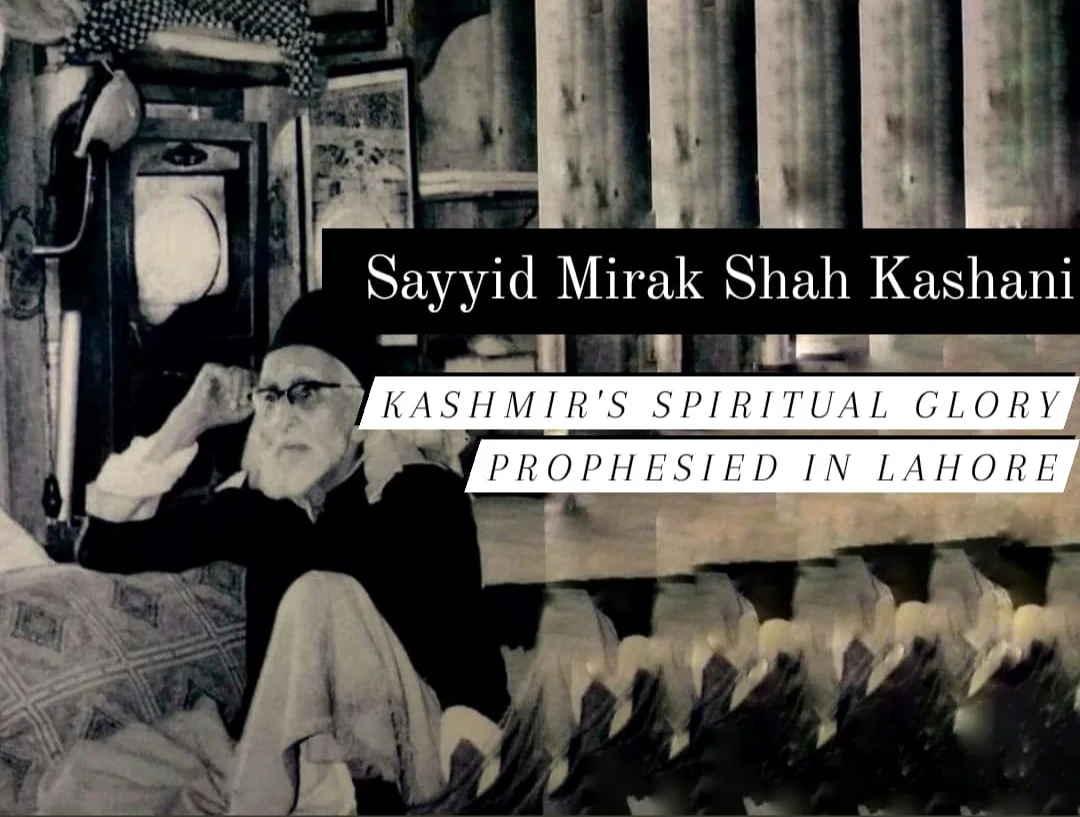
24Shawwal, the 10th month of Islamic [Hijri] calendar, is the death anniversary of Sayyid Mirak Shah Kashani of Shalimar, the 20th century’s most revered spiritual personality of Kashmir. It was on this day in 1391 Hijri (13 December 1971) – three days before the Indo-Pak War ended – that he breathed his last at the age of 76 following a brief illness. His demise was widely mourned in Kashmir and outside. Grieving people attended his funeral amidst cold weather, ongoing Indo-Pak war and dogfights in Srinagar’s skies. He was buried beside the graves of his predecessors, Hadrat Abdul Qudoos and Hadrat Laal Shah Sahib. Those blessed few who had the honour of lowering his body in the grave included a 21-year old college student, Mohammad Ismail Bhat. On the day of Sayyid Mirak Shah’s fateha or the congregational prayer meeting, a large number of mourners had assembled at his grave. They were addressed, among others, by politician Molvi Mohammad Sayeed Masoodi and Mirwaiz Molvi Mohammad Farooq.
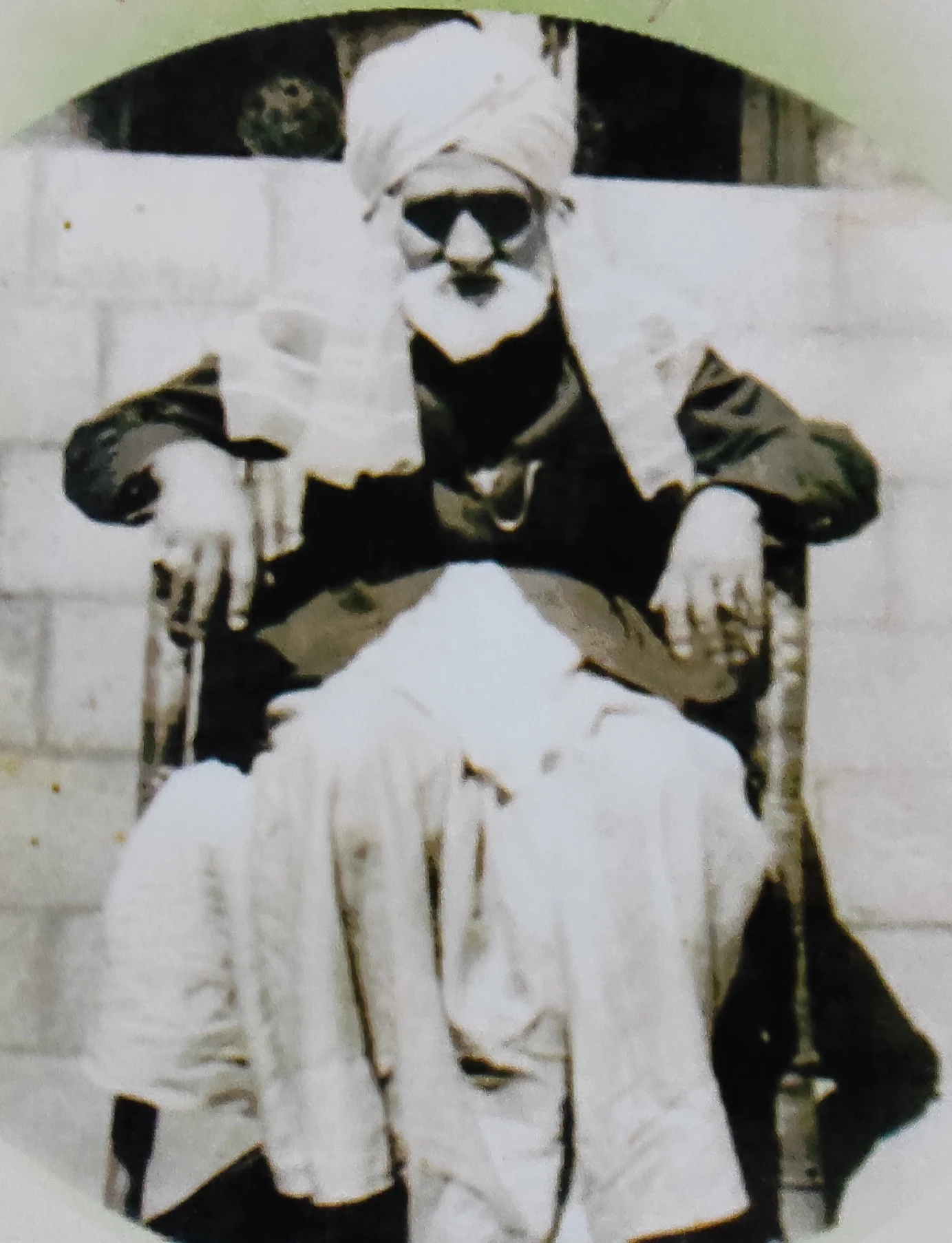
Strangely, a day before Sayyid Mirak Shah Kashani’s demise, a majzoob (absorbed ascetic), Kamal Kuchhay (also Kamal Sahib), had predicted his departure from the mortal world. Poet Mirza Arif Beg, as he had told my maternal uncle, was with Kucchay at Maisuma when he informed the ascetic, “Haekim hez draav” [The ruler has left], referring to the death of Chief Minister G. M Sadiq who had died at the Postgraduate Institute of Medical Sciences, Chandigarh that day (12 December). Kamal Sahib shot back, “Yi kusu haekim gov. Haekim ha neri pagah” [He was no ruler. The real ruler will leave tomorrow]. Mirak Saeb or Sahib, as he was fondly called, had ascended the gaddi (seat) following the demise of his murshid (spiritual anchor), Hadrat Abdul Qudoos, on 9 Zilqadah 1342 (1922 AD). He graced the Darbar-i-Kashania, as his Seat is now known, for 49 years. This year, on 9 Zilqadah, a fortnight from now, will be marked the 100th anniversary of his ascent to the Spiritual Throne at Shalimar. A very historic moment, indeed! Although he himself was from the Qadri silsila (order), he imparted teaching and spiritual practices in five orders of mysticism including Naqshbandi, Kubravi, Suharwardi, Qadri, and Chisti. Hundreds of them have profited from his guidance.
Fakir-i-Millat or the Nation’s Ascetic as he was reverentially addressed, Sayyid Mirak Shah Kashani’s ancestor, Sayyid Habibullah Kashani, had migrated from Kashan, a city in Isfahan province of Iran. Mirak Sahib was born to Sayyid Ahmad Shah Naqash of Saraf Kadal, a quarter of old Srinagar city, on 6 September 1895. According to his genealogy published by the Darbar-i-Kashania, Mirak Sahib was a descendent of Hadrat Ali (May Allah be pleased with him), the 4th Caliph of Islam and son-in-law of the Glorious Prophet (peace be upon him). Between the two, there was a chain of 36 generations. As Mirak Sahib told Ved Mehta in 1966, his spiritual lineage, passing through Mir Sayyid Ali Hamdani, also connected him to Hadrat Ali (May Allah be pleased with him) and, eventually, to Prophet Muhammad (peace be upon him). He was orphaned in infancy. His mother died when he was only two years old. Three years later, his father also passed away. Brought up by his brothers, he did not have any formal education beyond initiation in Qur’an, Hadith (sayings of Prophet Muhammad , peace be upon him) and some Persian literature like Sheikh Sadi’s Gulistan Bostan at the Ame Kaluin Madrassa (Ama Kaloo’s Seminary) in the city. When his brothers insisted on his having further education he refused and began spending his time in the company of fakirs, majzoobs and qalandars. He also started calligraphy of Qur’anic verses for raising some money to feed his companions. Mirak Sahib’s childhood mate and a neighbor at Saraf Kadal, Late Abdul Ahad Wani, once recalled that as children they would regularly go to the Jhelum to take a bath. While the rest of the children would not take much time young Mirak Shah remained in water for long, meditating. One day, as the children had a dip in the river others came out soon but not Mirak Shah. The children were shocked, waited for some time for him to reappear but as he did not, they returned to their homes without telling anybody about the incident. Next day, pleasantly amazed, they found him with them and ready for a bath.
From a very young age, he was a seeker of truth and enlightenment and, ultimately, attained a high spiritual place, arguably the highest among his contemporaries. In an interview with poet and broadcaster Ghulam Rasool Nazki recorded for the Radio Kashmir on 7 June 1967, Mirak Sahib narrated his initiation into the world of spirituality [translation]:
“At the age of 10, I was drawn to the path of Allah. Molvi Mohiuddin Khan of Nihalpora was my first pir in the Naqshbandi silsila (order). Around that time, my brother had a dream in which he saw me dead. It was announced there that Ghausal Azam (title of Sheikh Abdul Qadir Jeelani meaning great help or relief) will himself bathe the body. In a moment, accompanied by four persons and riding a horse, he arrived and took his position in the room as his four companions bathed my body, wrapped it in a shroud and took it away. This was the day when Ama Sahib [Molvi Ahmadullah Shah] had succeeded [as the Mirwaiz of Kashmir] Molvi Rasool Shah. My brother went to him for interpretation of the dream. He told him that you were from the Nashbandi silsila and he was now taken by Mehboob-e-Subhani [another title of Sheikh Abdul Qadir Jeelani meaning loved by Allah, the founder of the Qadri silsila]”
Mirak Sahib’s ascendency to spiritual heights was prophesied by Hadrat Fazlullah Shah Gardezi of Lahore before his birth. Gardezi was the spiritual guide of Hadrat Laal Shah Sahib. When he enthroned him and granted him permission to return to Kashmir, he told him, “The vilayat (spiritual charge) is transferred to you by a Sayyid [Gardezi] and this amanat (trust) has to reach another Sayyid whose name will be Sayyid Mirak Shah. He will be a progeny of Sayyid Habibullah Kashani. He will be born during your time but your successor will find him out.” On his return, Laal Shah Sahib kept on changing his abodes till he arrived at Shalimar where he founded Takia Laal Shah Sahib which is now known as Darbar-e-Kashania after Sayyid Mirak Shah Kashani. Laal Shah Sahib passed away on 12 Rabiut Thani 1306 Hijri and was succeeded by Hadrat Abdul Qudoos Mir or Qud Sahib who was from Shalimar. On divine hint, Qud Sahib located Mirak Sahib, who had been born 12 years ago and brought him into his circle of spirituality. Meanwhile, Mirak Sahib continued his tryst with the Truth, detaching himself from worldly affairs, sharing love and serving the needy. His brothers were worried for him and put him on the family vocation of naqashi (printing of shawls). Soon, he got rid of this avocation. Now, the family thought of getting him married to bring him back to normal life. He was married and soon was blessed with a daughter.
The marriage, however, did not withdraw him from his path. He remained mostly away from home, wandering from place to place. His elder brother admonished him for neglecting his wife and child. The reprimand saddened him and caused tears in his eyes. He prayed to Allah to bring him out of the dilemma. During the night, his brother informed him about the sudden death of his daughter. As tears rolled down his cheeks, he prostrated and accepted the incident as the will of Allah. Meanwhile, his absence from home forced his brothers to consider divorce of the couple so that the noble lady, who suffered but never complained, could start a new life. After divorce, Mirak Sahib continued with his wanderings and once spent about 10 months in the woods of Chra-i-Sharief with an ascetic named Ahad Sahib who eventually asked him to return to the city because Sheikh Abdul Qadir Jeelani (May Allah’s blessings be with him), in a vision, had ordered him to set him free, for he was not meant to stay in a forest but serve the people.
Mirak Sahib returned to Srinagar where he presented himself before Hadrat Qud Sahib at Shalimar who, eventually, made him his spiritual successor. Thus the amanat that Hadrat Fazlullah Shah Gardezi had transferred as a trust to Hadrat Laal Shah Sahib was finally delivered to Sayyid Mirak Shah Kashani. He ascended the gaddi at the age of 27 on the death of Hadrat Qud Sahib. Soon thereafter, his Seat attracted in hordes people in search of truth and ultimate reality or who sought healing to their spiritual or physical ailments. The visitors came from all faiths and from different places, the largest number being from the local Muslim community. There were Kashmiri Pandits, Sikhs and people from other states, and even countries, who sought his audience and blessings. His teachings were strictly in accordance with the Shariah and laid much emphasis on the first of the five fundamentals of Islam, namaz. When a Muslim visitor would inform him about what troubled him or her he invariably asked if he or she was punctual with namaz. “Namaz gatchi parein. Tche ti mang Khodayas bati mangas” [You must offer namaz. You pray to Allah and I will also pray for you], he would advise him or her. Several people came with varying issues like promotion or transfer, infertility and domestic discords. He told an interviewer that most of the people come to him with mundane issues and there were only a few who sought spiritual enlightenment. However, he would keenly listen to all. Once, a person complained that his cow was not giving enough milk. A person laughed at him which Mirak Sahib did not like. He told that person, “Piras wani ni teli kemis wani. Pir gov su yas yiti aasi pata zi muridas keatch tchheyi tuil chi pashas” [Who else will a murid tell his problem if not to his pir [spiritual guide]? A pir is one who knows how many hay-straws his murid’s cottage roof is made of.]
He ascended the gaddi at the age of 27 on the death of Hadrat Qud Sahib. Soon thereafter, his Seat attracted in hordes people in search of truth and ultimate reality or who sought healing to their spiritual or physical ailments. The visitors came from all faiths and from different places, the largest number being from the local Muslim community. There were Kashmiri Pandits, Sikhs and people from other states, and even countries, who sought his audience and blessings.
Among the visitors were rich and poor – common people, businessmen, shopkeepers, government employees and housewives. Prominent political leader and former Prime Minister, Sheikh Mohammad Abdullah, was one among them. When Abdullah, as the President Muslim Auqaf Trust, decided to reconstruct the Hazratbal Shrine in late sixties he first visited Shalimar to seek Mirak Sahib’s approval who, later, laid the foundation stone of the new building on 12 November 1969. Besides the Hazratbal Shrine and his own mosque at Shalimar, he laid foundation of several mosques including the Zindshah Masjid at Rainawari on 14 July 1961 and another at Sekidafar, Safa Kadal where Sayyid Qasim Shah Bukhari, religious scholar and founder of the Anjuman-e-Tableegul Islam, led Friday prayers. The Anjuman journal, Al-Tableeg, was published under his patronage. He would also organize annual Milad function at the famous Shalimar Garden to commemorate the birth of Prophet Muhammad (peace be upon him) where prominent religious scholars were invited. On this occasion, special dishes were cooked in the langar (kitchen). He also founded a darasgah (school) at Shalimar where children were imparted education in Qur’an and Hadith. Deen Mohammad, his spiritual successor, was one of the students. It is said that when he had his first lesson in Qur’an, Mirak Sahib was so happy that he himself served qahwa to the guests. Later, the school was upgraded to a high school during the time of Fakir Deen Mohammad.
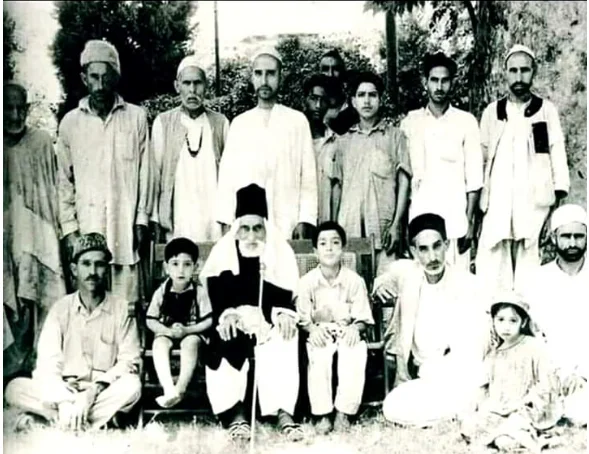
Kashmir was under an autocratic and oppressive rule when Sayyid Mirak Shah Kashani ascended the Spiritual Seat. Economically crushed, the people were deprived of all civil, political and human rights. Mirak Sahib could not remain unaffected by the situation and actively supported their movement against autocracy. He took part in processions and public meetings. In 1931, when about 60,000 people armed with axes, spears, lances and match-lock rifles gathered at Khanyar in a show-down with the oppressive regime, he came out of his Abode, mounted his horse with a naked sword in his hand and marched ahead of a large procession. On 31 December 1963, he arrived at the Jama Masjid Srinagar along with thousands of his supporters to attend a massive demonstration to protest the mysterious disappearance of the Holy Relic from the Hazratbal Shrine. In later years also, he was in touch with developments in Kashmir. Once he asked his disciple, Abdus Samad Khan, about what was going on in the Valley. He informed him that people were confused and concerned about their future because of the often changing political stand of Sheikh Mohammad Abdullah, who had been released from jail and was now speaking in different languages. This disappointed Mirak Sahab and the disappointment showed on his face. At that time, Abdullah arrived there and, reading Mirak Sahib’s face, asked him what the reason was. He told him to ask from Khan who found himself in a difficult situation of confronting a mass leader. However, in the presence of his murshid he summoned courage and told Abdullah that his changing stand was bothering and letting people down. Abdullah tried to explain that a leader had to plan according to the prevailing situation and might even temporarily order retreat of his troops to win a larger battle. Mirak Sahib asked Khan if he was convinced. He was not but kept quiet.
Kashmir was under an autocratic and oppressive rule when Sayyid Mirak Shah Kashani ascended the Spiritual Seat. Economically crushed, the people were deprived of all civil, political and human rights. Mirak Sahib could not remain unaffected by the situation and actively supported their movement against autocracy. He took part in processions and public meetings.
My earliest memory of Sayyid Mirak Shah Kashani is of early 1960s when as a kid I was taken to him by my mother. Most probably, my eldest aunt was also with us, for whenever mother ventured out of home, which was not often, it was mostly in her company. Mirak Sahib was seated in his second storey room. He was soft spoken with a frail body spotting a white beard and divine radiance. The ambience of the room looked heavenly. There were several visitors there who waited for their turn to move closer to him and seek his blessings. When our turn came, mother spoke to him about what had brought us to him. I do not remember what she told him but vividly recall that Mirak Sahib took a piece of bread in his mouth, chewed it, then took it out and, extending his right hand, offered it to me. I was reluctant to eat it but my mother, and possibly some others present there, persuaded me to open my mouth and have it without fuss. I obeyed.
The second time I saw Mirak Sahib was also during my childhood. He had come to my uncle’s house at Sonawar when the whole mohalla descended on the premises to have a glimpse of him. I have a bright recollection of him standing in the courtyard and then in the second storey room of my uncle who was married in the family of Mirs of Shalimar – also my grandmother’s maika (parental home) – a household very close to Mirak Sahib and from where his two time meals would come in spite of a fully provided for langar at the takia or the Seat of Mirak Sahib. The Mirs were connected with the takia from the times of Mirak Sahib’s predecessors. By virtue of this, our extended family at Sonawar enjoyed a special connect with Mirak Sahib. There was another close link of our family with him. My youngest maternal uncle, Abdus Samad Khan, was one of his closest disciples and would call him by the reverential title of Paadshah (emperor) or Fakir (ascetic). Mirak Sahib had a special love for him and had shared many a spiritual secret with him.
The third occasion I had the good fortune of sitting in front of Mirak Sahib and feel his blessed touch was in mid-1971, months before he left the transitory world for his eternal abode. My eldest brother, Dr. Mohammad Shafi, a frequent visitor to Mirak Sahib’s place, had been blessed with his first child (girl) and the latter had asked him to bring the baby to him. Mirak Sahib was positively disposed towards him. On the day my brother and his wife took the new born to Shalimar they asked me to accompany them. I was then a teenager. Mirak Sahib took the baby in his lap, gently caressed her and asked her father if the baby had been given a name. He replied in negative and requested him to do the honour. Mirak Sahib named the baby Nayeema (blessing), telling the couple that she is a neamat (favour) from Allah.
My next two interactions with Mirak Sahib were in the realms of vision. A few days before I left for Umrah in December 2017, I had a dream in which I saw him standing alone in the room of my uncle where I had physically seen him in my childhood. As I entered the room and greeted him, he opened his arms and warmly hugged me. I do not remember if we exchanged any words. The second time was in 2020 when I saw myself seated in Mirak Sahib’s room at Shalimar. Besides him, there were Deen Mohammad and a visitor with whom Mirak Sahib was conversing. Contrary to his usual sitting place, he was seated on the opposite side where visitors usually waited for audience. When the person had himself heard by Mirak Sahib and left the room, Deen Mohammad asked me, “Bashir Ahmada wothu thaavu darwaze band’’ [Bashir Ahmad, get up and bolt the door]. I bolted the door of the room from inside. As I turned back, Mirak Sahib told Deen Mohammad, “Yi chhui pan ni matlab aamut” [He has come for his own purpose]. Pertinently, preceding this, I had visited Mirak Sahib’s mausoleum with friend Mohammad Shafi a couple of times to offer fateha and seek Allah’s guidance in my research about an event in which he had played a significant role.
The Abode of Mirak Sahib was a two-storey old structure built in brick and wood with an adjacent small mosque, which he had constructed, and a fresh water spring infested with fish. An almost round-the-clock open langar was the hallmark of the place where hundreds of visitors were daily served qahwa (sweet brew) and local bread before they went upstairs to have audience with the spiritual giant. There were two langars, a small one located in the ground floor at the right end of the building, and the larger one outside of it which was reconstructed during the time of Fakir Deen Mohammad. Visitors contributed to the kitchen by offering rice, bread, sugar etc. The offerings were first presented to Mirak Sahib who would send these to the kitchen. Some visitors would make cash offering which was used either to run the kitchen or help the needy. The tradition continued during the time of Fakir Deen Mohammad and is followed when the Seat is occupied by his successor, Fakir Mohammad Dilawar. The attendants would once in a year visit different villages to collect food grains and money in donation for the kitchen.
At the taking-off point of the wooden stairway leading to the room of Mirak Sahib, one would observe dozens of pairs of footwear – slippers, leather sandals, rubber boots and khraves (wooden slippers) – lined up on the floor. On the narrow stairway people, as they waited for audience, sat nursing babies or eating food that they, having come from far off places, had brought with them. At the top of the stairway was a big room, a hall, where visitors sat on the floor cross-legged and in awe. The hall was divided by dabbedol, about three feet high wooden partition on the right side of which was a small wooden stairway leading to the langar and used only by close attendants when the main door was closed to let Mirak Sahib have a break to meditate or have some rest. On the western side of the hall, Mirak Sahib sat upright on his gaddi wearing a white turban (occasionally he used green colour) and a pheran (loose upper garment used by Kashmiris).
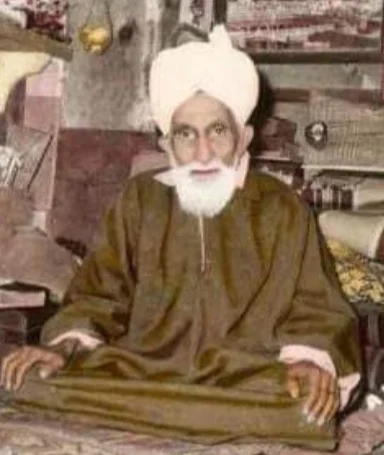
Occasionally, he also wore a black achkan (knee-length coat) and white pajama and spotted a Rumi topi (Turkish cap). He also carried a walking stick. A bowl of shirin (candy) and another of khaak poori (sacred ash wrapped in paper) were always handy drawing from which he would give some to visitors as tabaruk (sacrament). To some visitors, he would offer few sips from a surahi (ewer) of water in which he had earlier breathed out after invoking divine blessings. A clock with pendulum and neatly calligraphed and framed names of Allah and His Messenger (peace be upon him) adorned the wall behind him. A conspicuous presence in the room was a qumuir (Ground Thrush) in a cage hanging from the roof. The bird caught the attention of everybody for the sweet musical sounds it made.

Besides Deen Mohammad, the prominent attendants known as chailas of Mirak Sahib included Kamal Sahib who also performed the duties of a mouzzin (one who calls devotees for prayers) at the mosque, Mohammad Yusuf and Inayat alias Sani, a painter in the British Army from Peshawar who, while posted in Iraq, was directed in a dream by Sayyid Abdul Qadir Jeelani (Allah’s blessings be with him) to go to Kashmir for spiritual guidance from Sayyid Mirak Shah Kashani. Sani left the job and relocated to Shalimar. There was another attendant, Haji from Poona (Pune), who had performed Haj 25 times. Abdul Gani of Beerwah worked in the langar while Abdul Samad served qahwa to visitors. Abdul Ahad Mir was another attendant whose duty was to bathe the black-skinned horse of Mirak Sahib who was fond of riding a stallion. A visually impaired local resident, Abdul Aziz Dar (Harkar), was a regular visitor and would have long interactions with Mirak Sahib. He also recited na’ats or encomium on the Holy Prophet (peace be upon him). Once, Dar was deeply absorbed in a chat with Mirak Sahab when Kamal gave a call for prayers. It was winter time when, compared to summer, the interlude between asar, maghrib and isha prayers is shortened. Visibly irritated, Dar retorted, “Zan chhun Kamalas howmut baangan kun kath ti chhune diwan karne” [Looks like Kamal is obsessed with giving call for prayers; doesn’t let one talk]. The comment had Mirak Sahib bursting into laughter. It was a rare occasion when someone had seen him laughing so heartily. A conspicuous presence at Mirak Sahib’s Abode was Haba Moat, a born majzoob who was lodged in a ground floor room of the takia building. He was to Mirak Sahib what Zaki Shah majzoob was to Kashmir’s patron saint, Sheikh Hamzah Makhdoom Kashmiri or Makhdoom Sahib. A lady disciple, Jaane Saeb, was also a constant presence at the takia.

Mirak Sahib was receptive, sympathetic and kind with every visitor irrespective of his or her faith or status. As observed earlier, non-Muslims would also come to him for guidance. Dr. Mohammad Shafi recalls an incident. A gentleman clad in achkan and pajama and spotting a turban was waiting for audience. Mirak Sahib asked for a cup of milk for him and asked him, “Weniv Pandite kithkan chive aamet” [Panditji! What has brought you here?] He introduced himself as an employee of the Telegraph Department and said that he had come to seek spiritual guidance from him. He lamented that his long search for God was fruitless and he was now convinced that the Creator did not approve of his endeavor. He said that he had never touched haraam (the forbidden) in his life. Mirak Sahib enquired from him about his children upon which he told him that he was issueless. “You did not adopt a child?” he probed. The Pandit replied, “Yeli ne Dayan duit, mangte kyah anan” [When God decreed me not to have a child why to adopt one]. Caressing his hurt feelings, Mirak Sahib convinced him that only he seeks God whom God himself chooses to seek Him. He told him that since he was not from his faith he could not guide him. However, he assured him that a person from his own faith would soon lead him on his path. “I will also pray for you”, he told him.
Abdus Samad Khan would tell a story about heavy rains and thunderstorm lashing the Valley one day during the course of annual Amarnath Yatra. The weather was terrible and Khan observed signs of anxiety on the face of his murshid. He asked him why was he in a state of unease. Mirak Sahib told him that he was worried about the sadhus (Hindu monks) who were up in the mountains. Khan could not hide his confusion and asked, “But why must you worry for them?” Mirak Sahib replied, “Yim china Khodayi send bande? Yim ti hey chhi draamet temsie tchhhandni. Yihinz zimewaeri chhena” [Are they not God’s servants? They too have gone out in search of Him. Their safety is also my responsibility]. Those days very few sadhus, mainly from the plains of India, would embark on the Amarnath pilgrimage which had not been politicized then as it was during the recent years.
In 1963, a blasphemous incident of serious proportion pushed Kashmir into turmoil and chaos. On 27 December, Moe-e-Muqaddas (strand of hair of Prophet Muhammad, peace be upon him) was found missing from the Hazratbal Shrine. People came out on streets in tens of thousands, sobbing, protesting, raising slogans and demanding its return and punishment for the culprits. Normal life was paralyzed for days when the government made a sudden announcement about recovery of the lost relic. People refused to accept it as genuine unless identified by a group of religious leaders. There was no religious personality around more respectable and blessed than Sayyid Mirak Shah Kashani whose word people would readily accept. On 3 February 1964, a group of 14 religious leaders led by him identified the recovered relic as genuine. After the identification, there were some voices questioning how an old man with failing eyesight could have identified the relic. The word was allegedly spread by those who wanted to continue the mass uprising for political goals including the release of jailed Sheikh Mohammad Abdullah and demand for a plebiscite. I have interviewed people who had, post identification, heard Mirak Sahib confirming the genuineness of the recovered relic. In 1966, he had confirmed this to columnist Ved Mehta also.
Normal life was paralyzed for days when the government made a sudden announcement about recovery of the lost relic. People refused to accept it as genuine unless identified by a group of religious leaders. There was no religious personality around more respectable and blessed than Sayyid Mirak Shah Kashani whose word people would readily accept. On 3 February 1964, a group of 14 religious leaders led by him identified the recovered relic as genuine.
Sayyid Mirak Shah Kashani was a poet of substance who wrote devotional poems in Kashmiri language. The theme of his verses was Toheed (monotheism) and Ishq-e-Rasool (love of the Messenger of Allah). The Darbar-e-Kashania has published his poetic collection, Jaam-e-Irfan (Goblet of Knowledge), whose second edition was brought out in 2008. A sample:
Ae dil-e-man ma kar graav
Tchetas thaav Allah hu
Panun hosh pathar traav
Tchetas thaav Allah hu
Yaad karte mai kyah naav
Bood kornas naboodas
Boodas manz nabood chhaav
Tchetas thaav Allah hu
[My heart! Do not complain
Remember! Nothing exists beyond Allah
Toss your [glass of] consciousness
Remember! Nothing exists beyond Allah
Recall what my name is
He created me from inexistent
Enjoy your existence in a state of nothingness
Remember! Nothing exists beyond Allah]
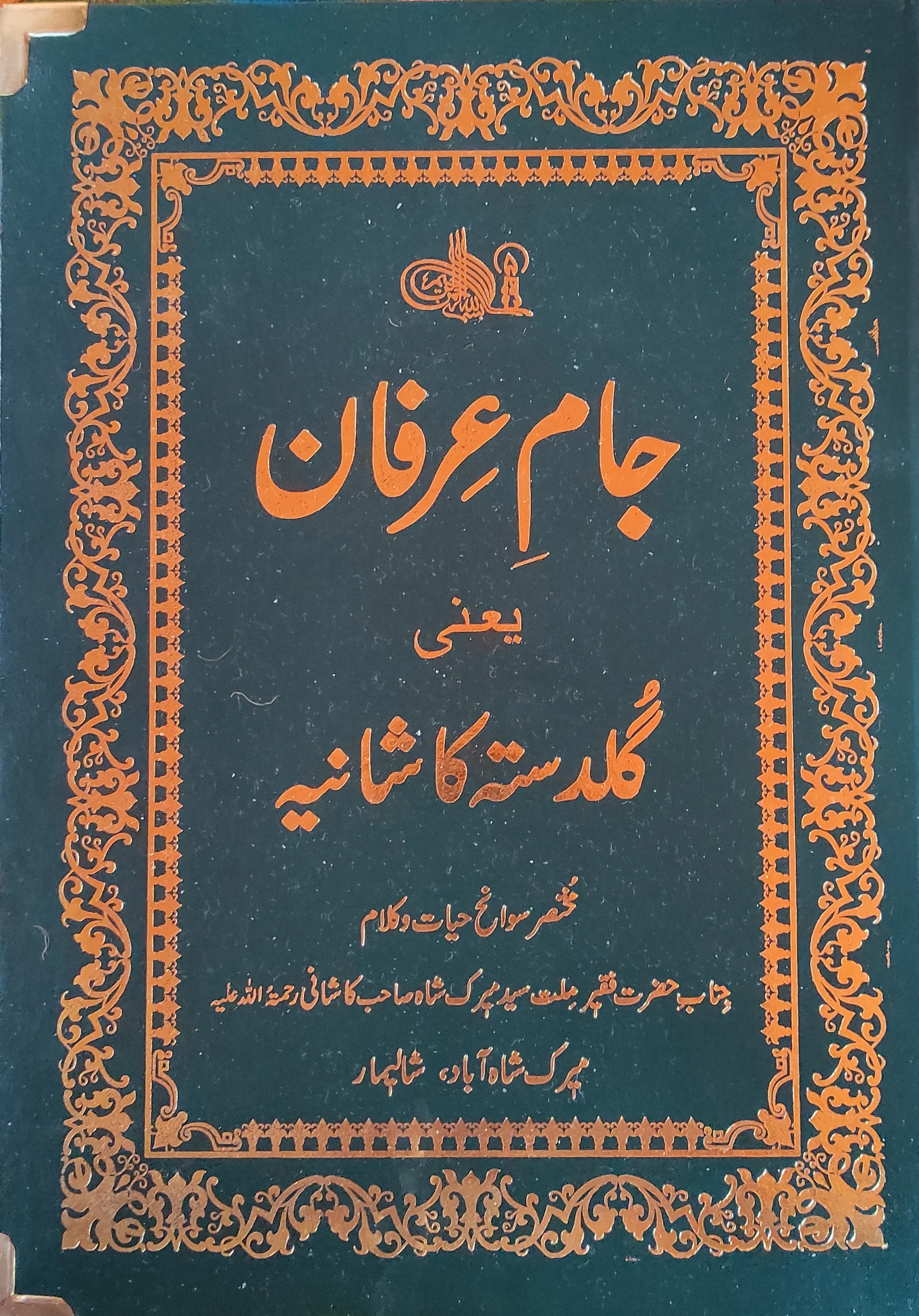
The mausoleum of Sayyid Mirak Shah Kashani, where besides his two predecessors, his successor, Fakir Deen Mohammad, is also laid to rest, draws a large number of devotees. It was built by Fakir Mohammad Dilawar.
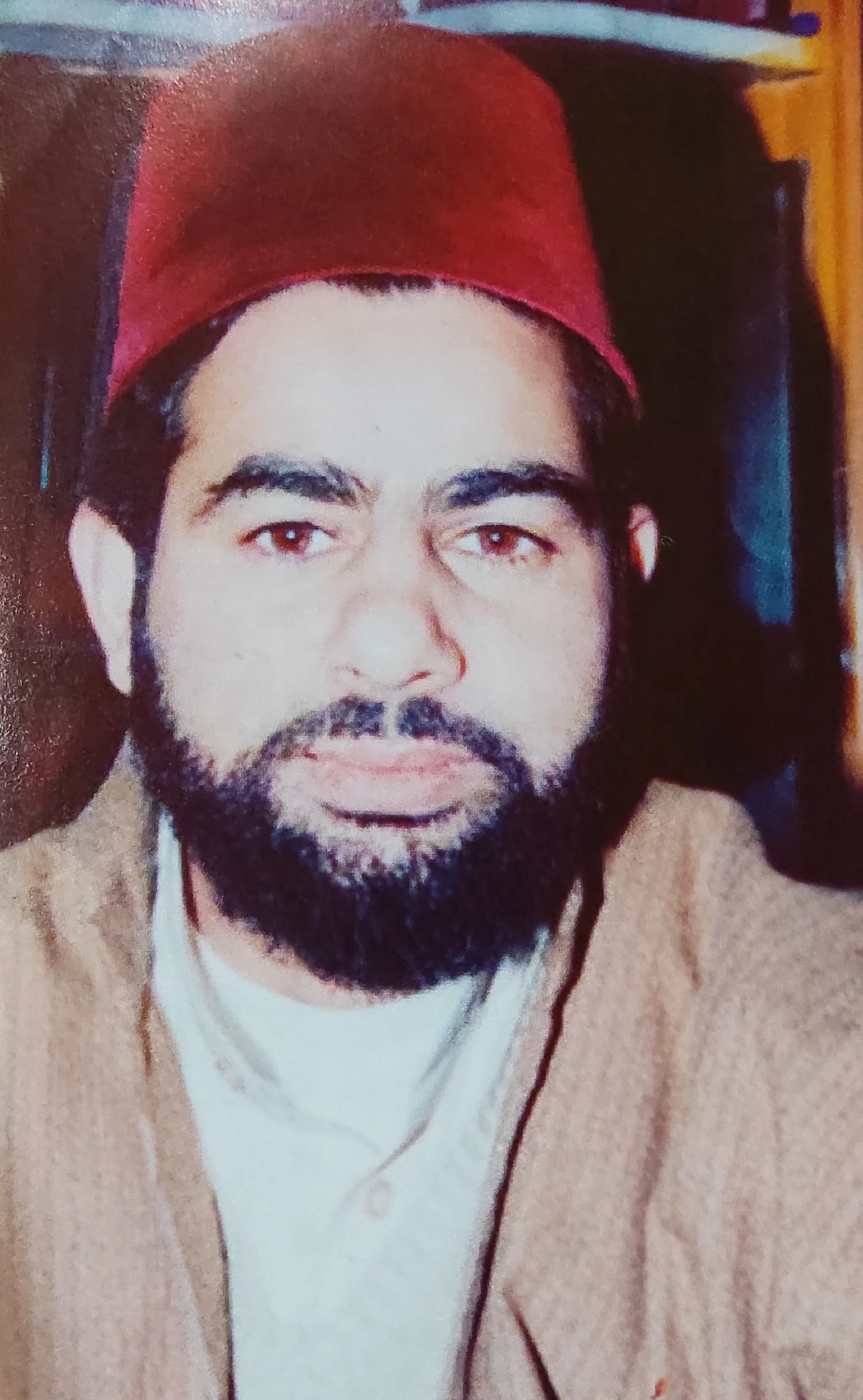
On the death anniversary of Mirak Sahib, a bhandaar (community feast) is served to the visitors. The old mosque was renovated and extended during the time of both Deen Mohammad and Mohammad Dilawar and is today a grand spacious masjid. The old takia building was also reconstructed and extended by them.
- Khalid Bashir Ahmad is a former civil service officer and author. His recent books include “Kashmir: Exposing the Myth Behind the Narrative” and “Kashmir: A Walk Through History”
Follow this link to join our WhatsApp group: Join Now
Be Part of Quality Journalism |
Quality journalism takes a lot of time, money and hard work to produce and despite all the hardships we still do it. Our reporters and editors are working overtime in Kashmir and beyond to cover what you care about, break big stories, and expose injustices that can change lives. Today more people are reading Kashmir Observer than ever, but only a handful are paying while advertising revenues are falling fast. |
| ACT NOW |
| MONTHLY | Rs 100 | |
| YEARLY | Rs 1000 | |
| LIFETIME | Rs 10000 | |











